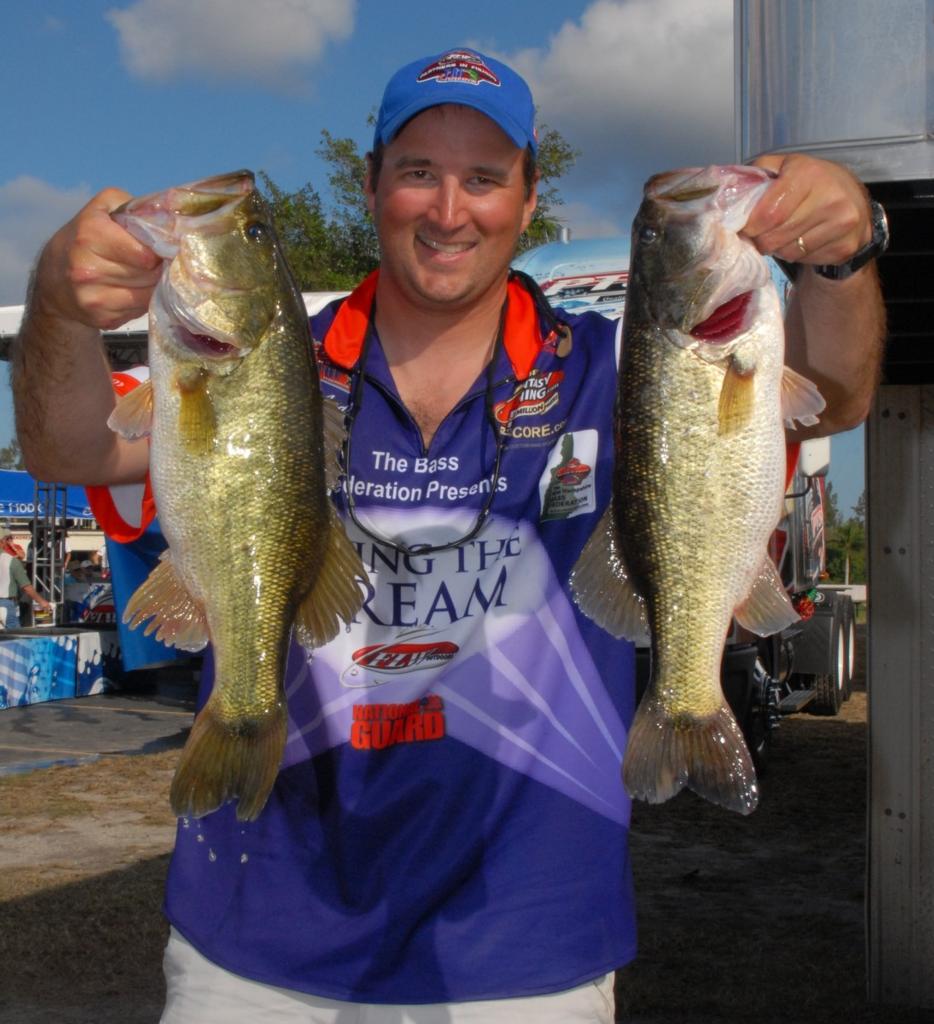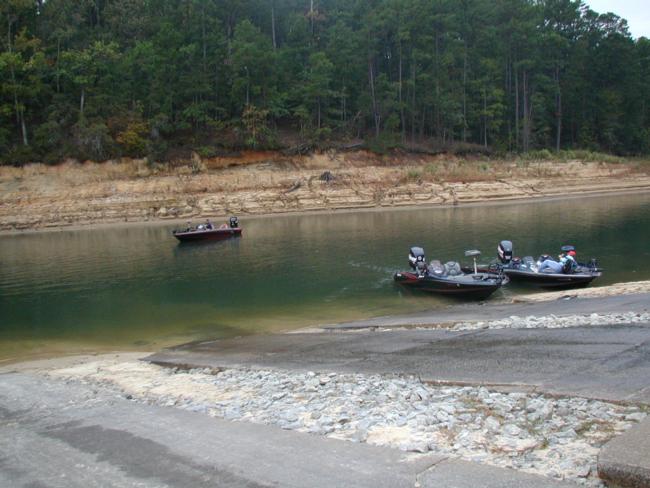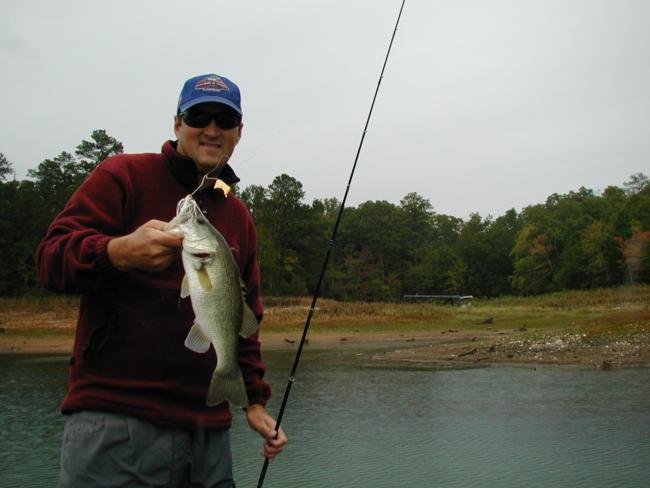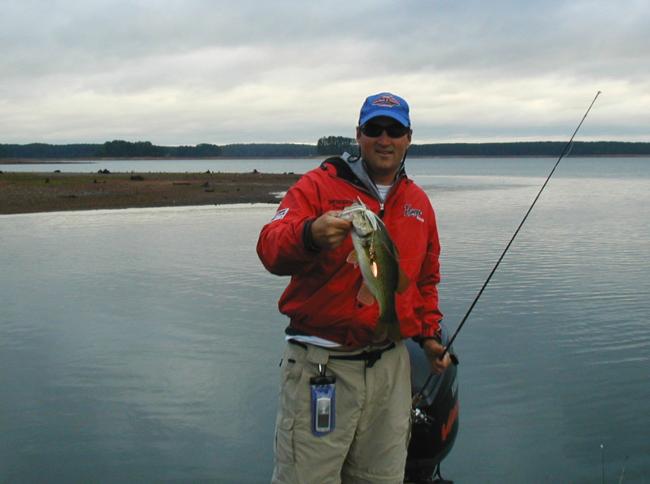Living the Dream: Clarks Hill, Part 1
Dave Andrews details first two days of practice for FLW Series event on Clarks Hill Lake

————————————-
Editor’s note: This is the first piece in a series of journal entries from Dave Andrews, winner of the 2007 TBF National Championship, detailing his fourth stop on the 2008 FLW Series Eastern schedule. Clarks Hill Lake marked the final event of his “Living the Dream” season. Entries were published at FLWOutdoors.com throughout the course of the season. As winner of the Living the Dream package, offered by FLW Outdoors through The Bass Federation, Andrews had his entry fees paid to test his club skills on the pro tour with the use of a fully wrapped boat and tow package. Andrews will chronicle his adventure in pro bass fishing, having most recently competed on Georgia’s Clarks Hill Lake. Segments of his journal will be posted approximately weekly. (Read his Lake Champlain journal; this links to the final entry, which provides links at the top for each preceding part)
————————————-
Walmart FLW Series BP Eastern Division
Stop No. 4: Clarks Hill Lake
Oct. 22-25, 2008
The fourth and final stop of the 2008 Walmart FLW Series schedule for the BP Eastern Division was on Clarks Hill Reservoir in Georgia. This would be my final event in the Living the Dream season. I had long ago run out of vacation time at work and would need to take an unpaid leave of absence to fish this one. My bosses at Wyeth Pharmaceuticals were very understanding and agreed to this.
There was no time for prefishing this event, and I’d never fished Clarks Hill before, or anywhere else in Georgia for that matter. I bought a map prior to leaving Massachusetts and figured I would go in cold and just follow my nose and try to fish the event from my gut instincts.
My co-angler and longtime fishing partner Scott Leppanen was back with me for one more go-round. Scott was at my house at 3 a.m. on Thursday, Oct. 16, and we left Bolton, Mass., shortly thereafter. The plan was to drive straight through to Augusta, Ga., where we would stay for the upcoming week. Towing the Living the Dream rig, we made excellent time, avoided all traffic jams and arrived at our motel at 8 p.m. that night. It was 1,000 miles, and we covered the distance in 17 hours. We were the only anglers staying out this far. It was kind of nice to be by ourselves. There was plenty of room to park the trailer without having to unhook, and there would be none of the usual hotel tournament distractions.

Official practice begins
Oct. 17
On Friday morning we headed off to Wildwood Park, the tournament launch site, to begin the first practice day. We had heard in advance that the lake would be low, 17 feet low to be exact, but we were still a little surprised to find the launch ramp at Wildwood Park closed. There was nobody around as the sun started to come up on the horizon.
We headed back toward a gas station to ask for directions to an open ramp. The folks inside said that most of the ramps were high and dry and not open. I was starting to get a little frustrated when I noticed Takahiro Omori’s Yamaha trailer drive past us. I quickly pulled out behind and followed him. Indeed, he led us right to a three-lane ramp that had just enough concrete to get into the water. We launched in Spring Creek and helped Tak get back to his boat that he had floated off, and soon we were heading out on Clarks Hill Reservoir for the first time.
It was late, probably 9 a.m., before we made our first cast. The weather was humid and muggy. High temperatures would make it into the 80s, and it would remain cloudy for the entire day. It seemed very “fishy.” We randomly picked a series of points and pockets near the Bussey Point region of the lake and went to work. Scott was throwing a topwater Lucky Craft Sammy, and I was working a small Yo-Zuri Popper.
The lack of water in the reservoir was alarming. The sand and clay points were totally exposed. We could see the tree line and original water line several hundred yards up the bank. We immediately noticed that thick, green hydrilla grew right along the shoreline and out from the points. We figured it would be the key structure for the bass to ambush prey. It was really the only cover that the bass had to work with near the shoreline.
Within minutes Scott hooked up with a solid 2-pound largemouth, and then I followed with one of my own about the same size. Both fish grabbed topwater baits at the edge of thick clumps of weeds in the back of little pockets. We picked away at a few more small keepers and eventually found ourselves  running up the Little River arm of the reservoir.
running up the Little River arm of the reservoir.
We passed the highway bridge over the Little River and stopped to throw finesse worms on a Gambler Giggy Head to the riprap. We boated six small keepers in about 45 minutes here. I figured this area would get hit hard during the tournament, but it might be a place I could go if I needed to finish my limit.
We moved on toward Grays Creek, driving through a minefield of standing timber. We were in 90 feet of water, but the tops of huge trees were standing just inches above the waterline. It made me wonder how many treetops were just below the surface. Other boats appeared to run right through the trees, so we followed suit.
Once safely into the back of the creek, we worked down the bank, throwing buzzbaits and poppers. It was early in the afternoon, and the skies had darkened significantly. The weather forecast called for a 20-percent chance of rain after dark, so we neglected to throw the rain gear in the boat. Sure enough, the skies opened and it poured for several hours. It’s good to know that the local Georgia weatherman is no better than the ones that work in New England. Within minutes we were soaked, but it was a warm rain and the bite was on, so we didn’t really seem to mind.
Largemouths were busting our topwaters as soon as they hit the water. We were fishing shallow grass edges mostly, occasionally stopping to drop a worm or jig into a sunken brush pile. We boated several decent keepers to maybe 3 pounds in this creek. Eventually the air temperature dropped, and we started to get chilled. When the trolling motor batteries began to fade, we figured it was time to come off the water and get ready for the second practice day.
Oct. 18
 Saturday was the second official practice day. Scott and I had gone online and printed a list of launches that were still open on Clarks Hill. There weren’t many, but we picked one that was several miles up the Savannah River and decided to trailer over. The plan was to fish up north toward the Russell Dam. It was still cloudy and drizzly in the morning, but the temperature had dropped into the low 60s, and the wind was blowing at 15 to 20 mph. The first two “open” ramps were actually closed or not viable for a full-sized bass boat. Eventually we found a small ramp that had just enough water to get the boat in. It was in the back of Reese Creek and unfortunately was only about 10 miles up the Savannah River from the Spring Creek launch.
Saturday was the second official practice day. Scott and I had gone online and printed a list of launches that were still open on Clarks Hill. There weren’t many, but we picked one that was several miles up the Savannah River and decided to trailer over. The plan was to fish up north toward the Russell Dam. It was still cloudy and drizzly in the morning, but the temperature had dropped into the low 60s, and the wind was blowing at 15 to 20 mph. The first two “open” ramps were actually closed or not viable for a full-sized bass boat. Eventually we found a small ramp that had just enough water to get the boat in. It was in the back of Reese Creek and unfortunately was only about 10 miles up the Savannah River from the Spring Creek launch.
It was well past sunup when we launched and headed over toward Parksville Creek. We picked a small arm of this rather large area, pulled up and began slinging spinnerbaits. My second cast produced a nice 2 1/2-pound largemouth bass. Within 15 minutes, I had caught four more solid keepers, all on the blade. The wind increased, and the clouds moved away. The bite died as the front pushed through, leaving a sunny, blustery day.
Scott and I headed several miles north, just looking at the shoreline, trying to get a feel of what fishing up here would be like. We went several hours without a keeper, but as the afternoon wore on, the sun and wind positioned some bass on the small, sharp points. We worked Rat-L-Traps and spinnerbaits and found that by hopping sharp points with weeds, we could pattern the fish pretty easily. There were several tournament boats practicing up this way, but it wasn’t hard to work around them. Even with the drought conditions, there were literally hundreds of creeks, points and pockets to explore.
That afternoon we boated nine or 10 more keepers, mostly on blades fished fast, just under the surface. Burning spinnerbaits is one of my favorite ways to catch smallmouths back home, and I was quite comfortable catching them this way. On one point, Scott and I both hooked up at the same moment. My bass was small, maybe 14 inches, but Scott’s was closer to 4 pounds. I punched in a waypoint, and we continued working our way back south toward the creek we had launched in.
By the end of the day, we had boated 16 or 17 keepers and had really started to pattern the fish at Clarks Hill. My best five fish weighed probably 10 pounds or so, and I felt pretty good about how the day went and what we had learned.
————————————-
Editor’s note: Stay tuned for Part 2, in which Andrews will write about days three and four of his official practice period at the FLW Series tourney at Clarks Hill Lake.
————————————-